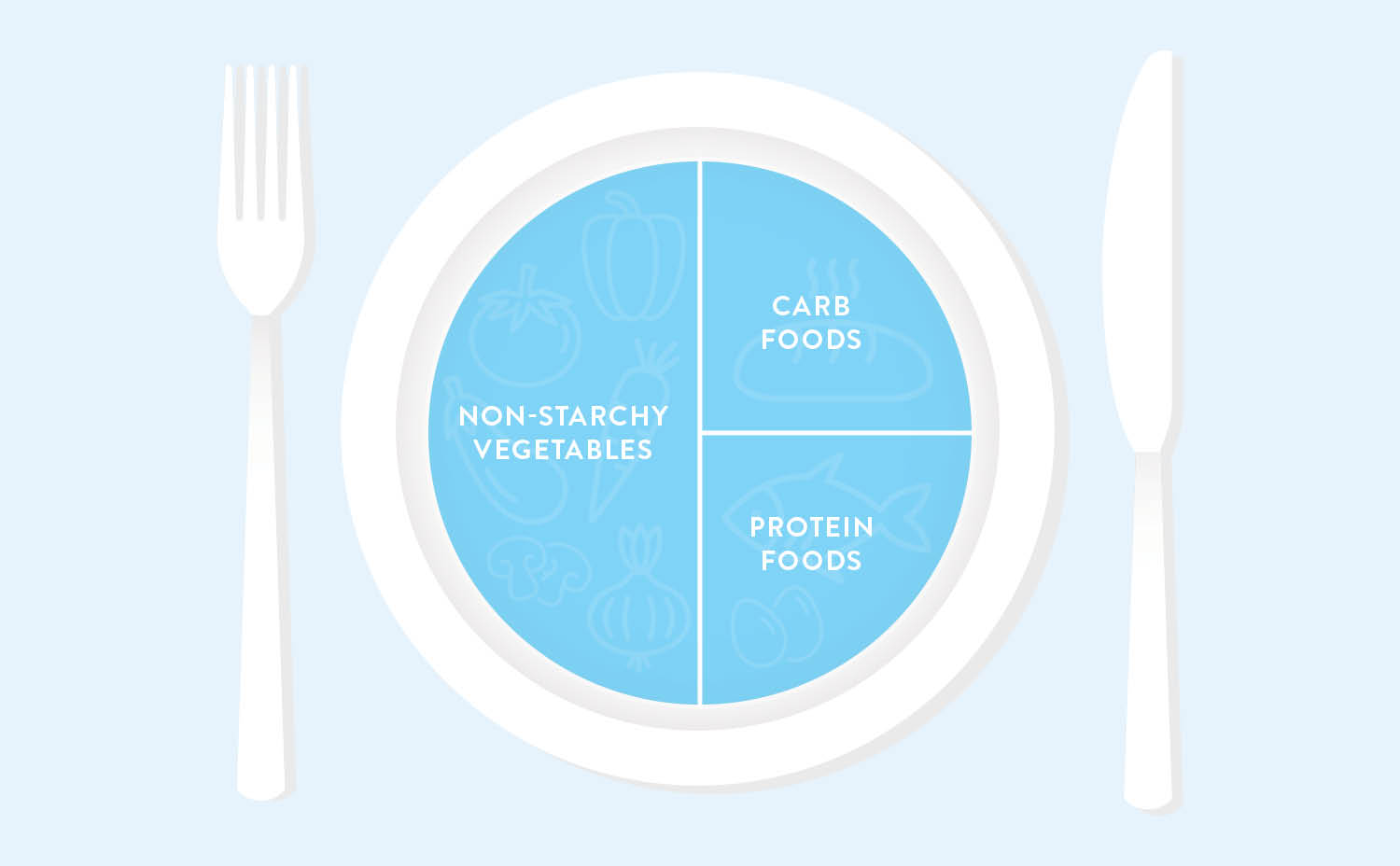(NOTE: Always consult with a healthcare provider before making any significant changes to diet or type 1 diabetes management.)
What to eat, what to eat…?
It’s a question that many ask without thinking too much about the consequences. But for someone who is living with type 1 diabetes, that simple question becomes more complicated. Now it’s dealing with calculations, complexities, and sometimes confusion.
For someone living with type 1 diabetes, what to eat can spark a series of spin-off questions:
- What is the right type 1 diabetes diet?
- Is there a type 1 diabetes meal plan?
- What foods should be avoided for a person with type 1 diabetes?
Hopefully the answers below will provide a little more guidance.
But first, let’s go over the basics of type 1 diabetes and how diet can play a role in daily management.

What is Type 1 Diabetes?
Type 1 diabetes (previously called juvenile diabetes) is an autoimmune disease where the body attacks the cells in the pancreas that produce insulin—the hormone responsible for allowing sugar (glucose) to be metabolized into energy. Insulin serves as a key to a locked door, according to Dr. Jordan Pinsker, vice president and medical director for Tandem Diabetes Care, and a leading pediatric endocrinologist. Insulin allows the cells of your body to open that door so the glucose can enter the cell and become energy.
Because someone living with type 1 diabetes doesn’t produce any, or enough insulin, they must start insulin therapy from when they are diagnosed. There is no cure for type 1 diabetes, so it requires daily insulin therapy and regular monitoring of blood sugars.
Certain types of food can contribute to high levels of glucose, which is why it’s important for individuals living with type 1 diabetes to monitor their diet.
A useful tool for making food choices is a Glycemic Index (GI), which assigns a number to food depending on its impact on glucose levels. There are many online indexes that you can print or download to use as a valuable resource. The higher the glycemic index number, the more quickly it can cause blood sugar to spike. A low GI number is considered to be less than 55, while a high GI rating is considered to be 70 and higher.
Positive Food Choices for Type 1 Diabetes
For a long time, low-carb diets were touted as the preferred meal plan for people living with type 1 diabetes. The truth is, there’s no gold standard for the “perfect” type 1 diabetes diet. While this may make daily life less simple, the good news is that it also makes eating plans less rigid.
There are three key takeaways that the American Diabetes Association (ADA) emphasizes when it comes to healthy eating patterns for people with diabetes. Keeping these points in mind will help create a more solid foundation and allow people with diabetes to feel increasingly empowered in their daily food choices.
The three factors are:
- Emphasis on non-starchy vegetables
- Minimal added sugars and refined grains
- Whole foods over processed foods whenever possible
It’s time to take these guidelines and apply them to the “plate.” Let’s look at what’s called the Diabetes Plate Method, which is the ADA’s technique for building a balanced meal for people with diabetes.
The ADA’s Diabetes Plate Method involves taking a 9-inch plate and filling it with the following portions (Note: you might have to adjust portion sizes depending on whether this is for an adult or a child.):
- Half plate for non-starchy vegetables
- Quarter plate for carbohydrates
- Quarter plate for protein
- Non-Starchy Vegetables
The ADA suggests dedicating half of a 9-inch plate to non-starchy vegetables. Starch is a type of carbohydrate that can be found in varying amounts in different foods. Despite the label, “non-starchy” vegetables like carrots and beets still contain starch, but not a lot of it.

Non-starchy vegetables include:
- Artichokes
- Asparagus
- Baby corn
- Beets
- Bean sprouts
- Brussels sprouts
- Cabbage
- Carrots
- Cauliflower
- Celery
- Cucumbers
- Dark leafy greens (like spinach, kale, and collard)
- Eggplant
- Green beans
- Jicama
- Mushrooms
- Onions
- Peppers
- Radishes
- Salad greens
- Sprouts
- Tomatoes
- Turnips
- Zucchini
What are Carbohydrates?
Carbohydrates can be divided into two categories: Simple and complex. Complex carbohydrates are often the healthier choice because they take longer to metabolize, which means steadier glucose and energy levels. The Plate Method recommends one-quarter of your plate should have carbohydrates.
Protein, fat, and fiber can all affect how quickly the body absorbs carbohydrates. When eating carbohydrates for a low blood sugar, it is helpful to stick to fast-acting carbohydrates such as glucose tabs, juice, or a regular soda. Eating something with fat, protein, or fiber with the carbs will delay the absorption of the carbohydrates and take significantly longer to bring up glucose. When having a low blood sugar, stay away from more complex foods like a candy bar, protein bar, or a high fiber muffin, as these will not raise glucose quickly.
So, which foods contain complex carbs? Think: Starchy vegetables and whole grains. Limit added sugars and refined grains when possible.
Starchy vegetables include:
- Butternut squash
- Corn
- Potatoes (Russet, Idaho, and Yukon Gold)
- Pumpkin
- Sweet potato
- Taro
- Whole grains include:
- Brown rice
- Buckwheat
- Couscous
- Farro
- Oats/Oatmeal
- Popcorn
- Polenta
- Quinoa
- Whole wheat
- Whole wheat products (like bread, pasta, tortilla)
What is Protein?
Protein provides energy, although the body’s preferred source of energy is still glucose. Protein is essential for tissue repair throughout the body. Sticking with the Plate Method, fill the last quarter with some protein. Below are some protein-rich foods that a person living with diabetes can enjoy most often.
Protein-rich foods that can be enjoyed often are:
- Chicken without skin
- Cottage cheese (nonfat or 1% fat)
- Eggs
- Extra lean ground beef (96% lean, 4% fat)
- Fish
- Legumes (like beans, lentils, & chickpeas)
- Nuts
- Pork (pork loin, tenderloin, and center loin)
- Tofu
- Top sirloin
- Turkey without skin
Other protein-rich foods not included on this list (like ribs and bacon) might still be enjoyed — just not as often. Again, there are no hard-and-fast rules, and it’s best to always consult a registered dietician and healthcare provider before making any dramatic changes to your diet.
Diabetes and Alcohol
For adults with type 1 diabetes, the ADA recommends no more than one drink a day for women, and no more than two drinks a day for men. Also keep in mind:
Alcohol can increase your risk of hypoglycemia because it inhibits the ability for the liver to release glucose (sugar)
Always consult with a healthcare professional to discuss possible interactions between alcohol and medications

Foods to Avoid with Type 1 Diabetes
Before diving into which foods to avoid or limit, keep in mind that there’s no such thing as “bad” food. Labeling certain types of food as “good” or “bad” can lead to feelings of guilt and shame around food and a higher risk of developing an eating disorder. For a person living with diabetes, being aware of their diet without sacrificing a positive attitude towards food might seem like a balancing act, but it is possible.
That said, here are food items that a person living with type 1 diabetes should be more mindful of, as they’ll have a higher impact on blood sugar levels. When a person collaborates with their healthcare team, they can develop a great sense of what works specifically for them.
Added Sugars (can be used for treating low blood sugar rather than everyday snacks/consumption)
- Sodas
- Some yogurts
- Sweetened fruit juices
- Refined Grains
- White bread
- White flour
- White rice
Certain Fats
Note: Certain fats can cause a delayed rise in blood sugar and sometimes a prolonged rise in blood sugar, but these can be a great supplement to other foods that increase calories without increasing carbohydrates.
- Butter
- Coconut oil
- Cream
- Full-fat, cream-based salad dressings (like ranch and bleu cheese)
- Lard
- Margarine

Type 1 Diabetes Diet & Meal Plans
The Diabetes Plate Method is a great starting point for people to feel empowered through their food choices and control blood glucose levels. But, there’s no textbook example of the perfect diabetes meal plan—just a plan that works for that individual, at that specific time in their life. That’s why having a registered dietitian (RD), along with a proactive care team, can be beneficial.
An RD creates customized meal plans, considers the person’s metabolic goals, budget, and of course, what the person actually enjoys eating. An RD also helps people develop healthy eating habits, along with cultivating a positive relationship with food along the way.
People frequently ask: “What about diets like keto? Can those help manage type 1 diabetes?” As of now, there is no diet that can help fully manage diabetes.
According to the ADA: “For adults with type 1 diabetes, no trials met the inclusion criteria for this Consensus Report related to Mediterranean-style, vegetarian or vegan, low-fat, low-carbohydrate, DASH, paleo, Ornish, or Pritikin eating patterns. We found limited evidence about the safety and/or effects of fasting on type 1 diabetes.”
Remember that diet is just one component of diabetes management along with regular exercise and insulin therapy.
Unless otherwise noted, all medical information was provided by Jordan Pinsker, MD, and Molly McElwee Malloy, RN, CDCES of Tandem Diabetes Care, Inc.